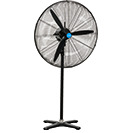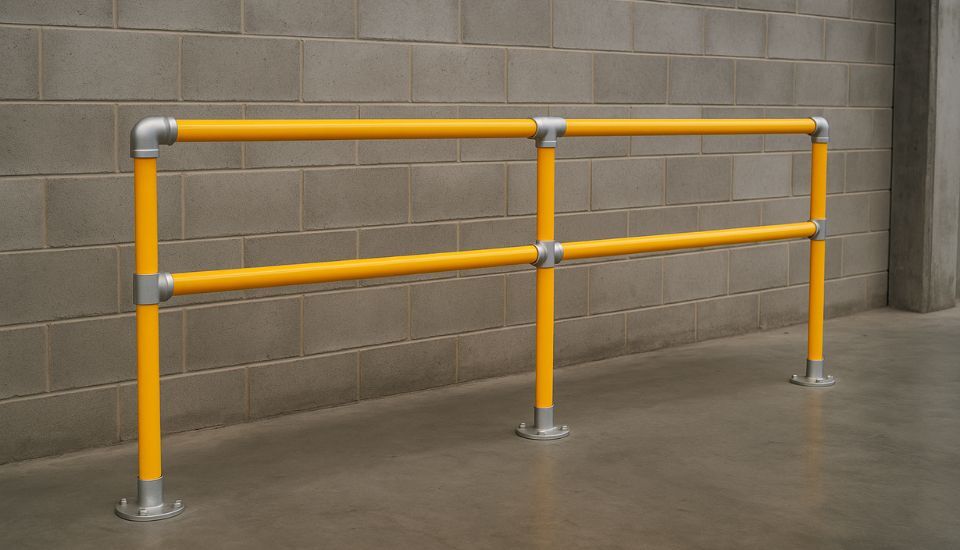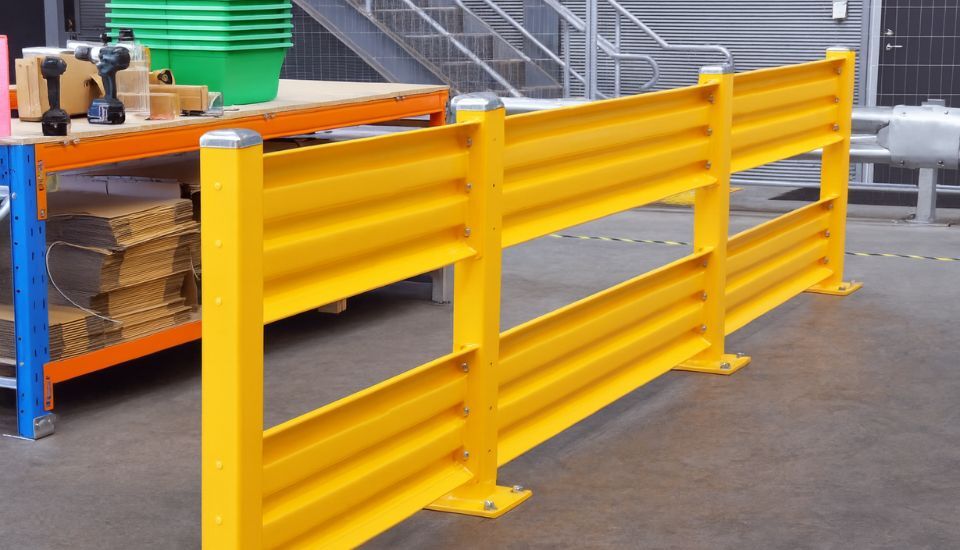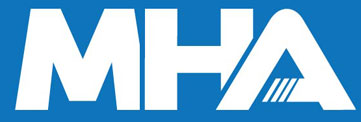6 Types of Safety Barriers Used in Industrial Workplaces
Date Posted:11 September 2025
Explore 6 safety barrier types proven in industrial workplaces. Each offers unique strengths for traffic flow, asset protection, and compliance. Safer operations begin here.
Verdex Insights: At a Glance
-
The Challenge: Many workplaces still underestimate the importance of choosing the right safety barriers for separating people, vehicles, and equipment. Without proper systems in place, even minor incidents can lead to costly damage, downtime, and compliance breaches.
-
The Insight: Safety barriers are essential for preventing accidents, guiding traffic, and protecting both people and infrastructure. From guardrails and bollards to modular systems, each type plays a specific role in meeting WHS requirements and improving site efficiency.
-
The Verdex Solution: Verdex provides WHS-compliant safety barriers, bollards, guardrails, and modular systems designed for warehousing, logistics, construction, and manufacturing environments. Our durable, high-performance solutions help businesses stay compliant, reduce risk, and keep their worksites running safely and efficiently.
What Are Safety Barriers?
Safety barriers are physical structures designed to prevent accidents, guide traffic, and protect both people and property in the workplace. Whether it’s separating pedestrians from forklifts in a warehouse or shielding machinery from collisions, these barriers play a vital role in creating a safer, more organised work environment.
In the Australian workplace, safety barriers also help businesses meet legal obligations under Work Health and Safety (WHS) regulations. From warehouses to manufacturing plants, using the right barrier reduces the risk of injury, downtime, and damage to infrastructure. More than just a precaution, they’re a proactive step towards compliance and peace of mind.
The Importance of Using the Right Type of Safety Barrier
Choosing the right barrier isn’t just about ticking a compliance box — it’s about safety, efficiency, and long-term savings. Here’s where it really matters:
Separating Vehicles from Pedestrians
One of the most critical functions of a safety barrier is keeping people and moving machinery apart. Forklifts and foot traffic don’t mix — especially in fast-paced environments like warehouses or loading docks. At Verdex, we understand how material handling equipment and well-placed barriers can transform high-risk areas into safe, efficient spaces.
Machinery Protection
Some equipment is too expensive — or too dangerous — to leave unguarded. Barriers create a buffer zone, stopping accidental bumps, keeping unauthorised staff at a safe distance, and helping prevent both injury and costly repairs.
Warehouse Traffic Flow
A well-placed barrier doesn’t just block danger — it guides movement. Whether it’s forklifts, trolleys, or foot traffic, barriers help direct flow, reduce confusion, and cut down on workplace congestion. No more guesswork, no more close calls.
Long-Term Cost Saving
The right barrier, in the right place, can save a fortune over time. Fewer accidents mean less downtime, reduced damage, and fewer hassles with insurance or compliance. It’s a classic case of prevention being far cheaper than the cure.
Beyond protection, barriers work hand-in-hand with other workplace safety equipment and supplies to reduce accidents and ensure compliance.
6 Types of Safety Barriers Used in Industrial Workplaces
There’s no one-size-fits-all when it comes to safety barriers. Different workplaces — and even different zones within a site — call for different solutions. Here’s a breakdown of the most common types and where they shine.
1. Guardrails
Guardrails are one of the most widely used safety barriers in industrial settings — and for good reason. These tough, highly visible rails act as a clear physical separation between people and moving machinery. Whether it’s protecting pedestrian paths, reinforcing warehouse walls, or outlining vehicle routes, guardrails are often the first line of defence.
Used for:
Separating forklifts from pedestrian walkways, structural supports, and work areas.
Benefits:
Highly visible, impact-resistant, and available in modular systems for flexible installation.
Ideal for:
Warehouses, loading docks, manufacturing lines, and high-traffic industrial zones.
2. Bollards
Short, solid, and seriously strong — bollards are designed to stop things in their tracks. These vertical posts are often placed at entry points, doorways, or around valuable infrastructure to prevent vehicle intrusion and protect against accidental collisions. Despite their size, they’re one of the most reliable safety measures for high-risk areas.
Used for:
Preventing vehicle intrusion and shielding doorways, pallet racking, or machinery from accidental impact.
Benefits:
Exceptionally durable, low maintenance, and available in both flexible and high-strength fixed models.
Ideal for:
Car parks, warehouse entries, building corners, and areas near high-value equipment.
Despite their size, barriers and bollards remain one of the most reliable measures for high-risk entry points.
3. Pedestrian Safety Barriers
When vehicles and foot traffic share the same space, pedestrian barriers are critical. They define safe walking paths, prevent accidental access to danger zones, and help keep traffic flowing in a controlled and predictable way. They're also great for supporting WHS compliance through clear visual demarcation.
Used for:
Guiding and separating foot traffic in shared areas with vehicles or machinery.
Benefits:
Boosts visibility and compliance, reduces human error, and clearly defines pedestrian zones.
Ideal for:
Warehouses, logistics centres, event venues, and any environment with mixed traffic.
Even with clear pedestrian zones, incidents can still happen, which is why accessible workplace first aid kits are another vital layer of protection.
4. Pallet Rack Guards
Warehouse racking systems are major investments — and without protection, they’re also a major liability. Rack guards protect the upright frames of pallet racks from being damaged by forklifts, pallet jacks, or trolleys, reducing the risk of structural failure or collapse.
Used for:
Protecting pallet racking uprights from impact damage caused by equipment or stock movement.
Benefits:
Prevents costly repairs, supports safety inspections, and extends the life of racking systems.
Ideal for:
High-density storage areas, bulk goods warehouses, and cold storage environments.
5. Machine Guards
Machine guards are safety barriers built to isolate hazardous equipment. They protect workers from contact with moving parts and help prevent unintentional interference or tampering. For many industrial sites, machine guarding isn’t just smart — it’s legally required under WHS regulations.
Used for:
Creating physical separation between people and moving or dangerous machinery.
Benefits:
Minimises injury risk, keeps unauthorised personnel out, and supports WHS compliance.
Ideal for:
Manufacturing floors, workshops, production lines, and automated systems.
These barriers minimise risk and keep unauthorised staff out, but they should always be paired with PPE clothing and safety gear for maximum protection.
6. Modular Barrier Systems
Modular barriers offer flexibility for evolving workspaces. These systems can be reconfigured or expanded as needed, making them ideal for temporary work zones, changing warehouse layouts, or sites with shifting traffic patterns. They're also quick to install and easy to maintain.
Used for:
Providing adaptable protection that can be repositioned or scaled with minimal effort.
Benefits:
Lightweight, customisable, and cost-effective without sacrificing durability.
Ideal for:
Dynamic warehouse spaces, temporary work zones, and project-based operations.
Choosing the Right Barrier for Your Facility
Not every workplace needs heavy-duty bollards or full-length guardrails — but every workplace needs the right barrier in the right spot. Start by assessing your site layout: where do people and vehicles cross paths? Which zones are high-risk?
From there, factor in impact resistance — do you need something that can take a forklift hit or simply guide foot traffic? Whatever you choose, make sure it ticks the WHS compliance boxes and is supported with clear workplace safety signage. A little planning up front can prevent a lot of damage, confusion, and downtime down the track.
Why Choose Verdex for Safety Barrier Solutions
For over two decades, Verdex has helped get hard-working Aussies home safely to their loved ones. We’re not just about safety checklists — we’re about real-world protection that holds up when it counts.
From tough-as-nails bollards to fully custom barrier systems, we supply WHS-compliant solutions that reduce risk, cut downtime, and keep worksites moving. With fast delivery, friendly service, and proper boots-on-the-ground know-how, Verdex is the safety partner Aussie businesses trust.
Frequently Asked Questions
Are safety barriers required by law in Australia?
Yes. Australian Work Health and Safety (WHS) laws, supported by various Australian Standards (e.g., AS 1657 for fixed structures, AS/NZS 3845 for road safety barriers, AS 1742 for traffic control), legally require safety barriers in workplaces where there is a risk of falls, collisions with vehicles/plant, or other hazards. These are critical for worker and public safety.
What industries most commonly use safety barriers?
Safety barriers are used across a wide range of industries — from warehousing, logistics, and construction to manufacturing, retail, and commercial property. Any environment where people and equipment move in close proximity can benefit from well-placed barriers.
Can barriers be used outdoors?
Absolutely. Many safety barriers are specifically designed for outdoor use and built to withstand harsh Aussie weather. Just make sure you’re selecting materials suited to your environment — such as UV-resistant plastics, galvanised steel, or heavy-duty coatings.
How often should I inspect or replace safety barriers?
Safety barriers should be inspected regularly, typically daily, weekly, or monthly, depending on the type of barrier and its usage. A more thorough inspection should be conducted annually, or as per the manufacturer's recommendations. Damaged or deteriorated barriers should be repaired or replaced promptly.
Does Verdex offer custom safety barrier solutions?
Yes — Verdex offers custom barrier solutions tailored to your site layout, risk areas, and operational needs. Whether you need a full system design or just advice on what fits best, get in touch with the Verdex team for expert support.






















































































 Trolleys & Hand Trucks
Trolleys & Hand Trucks Cage Trolleys
Cage Trolleys Cleaning Carts & Trolleys
Cleaning Carts & Trolleys Construction Trolleys
Construction Trolleys Custom Trolleys
Custom Trolleys Hand Trucks & Dollies
Hand Trucks & Dollies Laundry/Linen Trolleys
Laundry/Linen Trolleys Lifting Trolleys
Lifting Trolleys Order Picking Trolleys
Order Picking Trolleys Panel Cart Trolleys
Panel Cart Trolleys Platform Trolleys
Platform Trolleys Powered Trolleys
Powered Trolleys Shelf & Tiered Trolleys
Shelf & Tiered Trolleys Shopping Trolleys
Shopping Trolleys Stainless Steel Trolleys
Stainless Steel Trolleys Tool Trolleys
Tool Trolleys Utility & Service Carts
Utility & Service Carts Lifting & Handling Equipment
Lifting & Handling Equipment Forklift Attachments
Forklift Attachments Jib Attachments
Jib Attachments Lifting Hoists & Pallet Hooks
Lifting Hoists & Pallet Hooks Load Skates & Tow Tugs
Load Skates & Tow Tugs Manual Stackers & Lifters
Manual Stackers & Lifters Pallet Jacks
Pallet Jacks Pallet Lifters
Pallet Lifters Pallet Rotators & Dispenser
Pallet Rotators & Dispenser Powered Pallet Trucks & Electric Lifters
Powered Pallet Trucks & Electric Lifters Scissor Lift Trolleys and Tables
Scissor Lift Trolleys and Tables Conveyor Equipment
Conveyor Equipment Conveyor Frames & Stands
Conveyor Frames & Stands Roller & Skate Conveyors
Roller & Skate Conveyors Ladders & Access Equipment
Ladders & Access Equipment Container & Yard Ramps
Container & Yard Ramps Ladders & Step Stools
Ladders & Step Stools Work Platforms & Crane Cages
Work Platforms & Crane Cages Drum Handling Equipment
Drum Handling Equipment Drum Storage & Bunding
Drum Storage & Bunding Drum Trolleys & Lifters
Drum Trolleys & Lifters Forklift Drum Handling
Forklift Drum Handling Waste Handling & Bins
Waste Handling & Bins Bin Lifters & Tippers
Bin Lifters & Tippers Plastic Waste & Wheelie Bins
Plastic Waste & Wheelie Bins Steel Waste & Tipping Bins
Steel Waste & Tipping Bins Waste Carts
Waste Carts Dangerous Goods Storage & Spillage
Dangerous Goods Storage & Spillage Aerosol Cans Storage Cages
Aerosol Cans Storage Cages Bunded Pallets & Storage
Bunded Pallets & Storage Corrosive Goods Storage Cabinets
Corrosive Goods Storage Cabinets DG Storage & Trolleys
DG Storage & Trolleys Flammable Liquid Cabinets
Flammable Liquid Cabinets Forklift Gas Storage Cages
Forklift Gas Storage Cages Site Storage
Site Storage Spill Kits
Spill Kits Shelving & Storage Equipment
Shelving & Storage Equipment Stillage & Transport Cages
Stillage & Transport Cages 750 Series Cage Configurations
750 Series Cage Configurations Heavy Duty Cabinets
Heavy Duty Cabinets Heavy Duty Shelving
Heavy Duty Shelving Mega Bins & Pallets
Mega Bins & Pallets Packing & Workbenches
Packing & Workbenches Parts Trays & Stor-Pak Bins
Parts Trays & Stor-Pak Bins Pegboard & Louvre Panels
Pegboard & Louvre Panels Plastic Bins & Crates
Plastic Bins & Crates Plastic Handling Solutions Bins
Plastic Handling Solutions Bins Plastic Pallets
Plastic Pallets Stack & Nest Bins
Stack & Nest Bins Pallet Racking Accessories
Pallet Racking Accessories Workplace Equipment
Workplace Equipment Modular Workbenches
Modular Workbenches Electric Height-Adjustable Workbenches
Electric Height-Adjustable Workbenches Floor Matting
Floor Matting General Workplace Equipment
General Workplace Equipment Industrial Weighing Scales
Industrial Weighing Scales Packaging Machinery
Packaging Machinery Stationery Cupboards
Stationery Cupboards Storage and Stillage Cages
Storage and Stillage Cages Tool Trolleys
Tool Trolleys Tooling Cabinets
Tooling Cabinets Workshop Fans and Coolers
Workshop Fans and Coolers Safety Barriers, PPE & Signage
Safety Barriers, PPE & Signage Barriers & Bollards
Barriers & Bollards First Aid Equipment
First Aid Equipment Gloves, Knives and PPE
Gloves, Knives and PPE Signage
Signage Cleaning & Site Supplies
Cleaning & Site Supplies Cleaning Equipment
Cleaning Equipment Cleaning Trolleys
Cleaning Trolleys Rubbish Bins
Rubbish Bins Signs & Traffic Supplies
Signs & Traffic Supplies Construction Equipment
Construction Equipment Construction Trolleys
Construction Trolleys Waste Handling
Waste Handling General Site Equipment
General Site Equipment Concrete Equipment
Concrete Equipment Site Storage
Site Storage Lifting Equipment
Lifting Equipment











